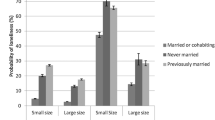Abstract
Background: Dissociative symptoms are common psychiatric symptoms whose prevalence in rural (agricultural) populations is unknown. The present study examines the prevalence of depersonalization and derealization experiences in a southern rural US population as well as socio-demographic and emotional factors associated with these experiences. Method: A random sample of 1008 adults in rural eastern North Carolina completed a survey by telephone, which included questions about experiences of depersonalization or derealization in the past year. Demographic information was gathered on all respondents; for those reporting these dissociative experiences, information on their frequency, duration, and whether they occurred during conditions of danger, severe stress, upsetting memories, nervousness or depression, or for no apparent reason was also elicited. Results: The reported prevalence rates were 19.1% for depersonalization, 14.4% for derealization, and 23.4% for either dissociative experience. Logistic regression showed that women reported a significantly higher rate of dissociative experiences (26.5%) than men (19.5%), (Odds Ratio=1.93, 95% CI= 1.37–2.74), particularly African-American women (29.9%). Experiencing chronic pain (OR=2.96, 95% CI= 2.05–4.28) and irregular church attendance (OR= 1.18, 95% CI=1.07–1.31) were also associated with increased frequency of dissociation. Increasing age (OR=0.73, 95% CI=0.65–0.81) and being employed (OR=0.58, 95% CI=0.39–0.86) were associated with reduced frequency of dissociation. Pain, gender, and age were related to both depersonalization and derealization experiences. Employment and church attendance were related to depersonalization experiences, while ethnic minorities experienced more derealization. Conclusions: A predominantly southern rural population reported a high 1-year prevalence of depersonalization and derealization experiences. The prevalence of dissociation experiences was common in this southern sample, as was found by Ross and colleagues (1990) in an urban population in Canada. Risk factors for depersonalization and derealization experiences had considerable overlap, but differed on several variables suggesting different underlying mechanisms.
Similar content being viewed by others
Author information
Authors and Affiliations
Additional information
Accepted: 4 October 2000
Rights and permissions
About this article
Cite this article
Aderibigbe, Y., Bloch, R. & Walker, W. Prevalence of depersonalization and derealization experiences in a rural population. Soc Psychiatry Psychiatr Epidemiol 36, 63–69 (2001). https://doi.org/10.1007/s001270050291
Issue Date:
DOI: https://doi.org/10.1007/s001270050291




